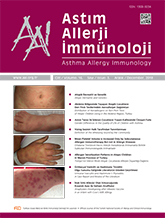


Objective: The aim of this study was to analyse the impact of gender differences using the Pediatric Asthma Quality of Life Questionnaire (PAQLQ) following daily inhaler corticosteroid therapy in children and adolescents with persistent asthma.
Materials and Methods: Children between 7-17 years of age with a diagnosis of persistent asthma who were not on daily inhaler corticosteroid therapy were involved. At enrollment, sociodemographic and asthmatic characteristics were investigated and pulmonary function test (PFT), asthma control test (ACT) and PAQLQ were administered. Patients were reevaluated following six weeks of regular inhaler therapy and ACT, PAQLQ and PFT were repeated. The scores from these tests were compared by gender.
Results: Out of 62 patients, 27 (43.5%) were female. Although the mean FEV1% and the mean FEV1/FVC ratios of PFT for girls both at enrollment and following 6 weeks of daily inhaler therapy were statistically higher than the ratios for boys, the mean symptom scores, and activity scores and total scores of PAQLQ were significantly lower in girls both at enrollment and following therapy. The mean ACT scores for girls and boys were similar at enrollment but were significantly higher in boys following daily inhaler therapy (p=0.025). The activities with the most limitation due to asthma were running (88.6%), going upstairs (54.3%) and climbing (22.9%) for girls and running (83.3%), playing football (73.8%) and going upstairs (28.6%) for boys.
Conclusion: Gender affects the quality of life in children with asthma. The girls had lower quality of life. This could be due to girls being more emotional and more subjective about their illnesses.